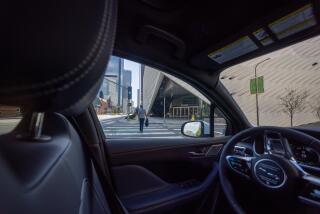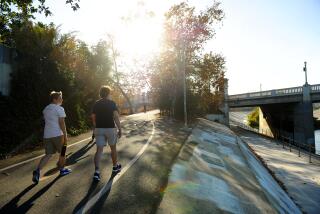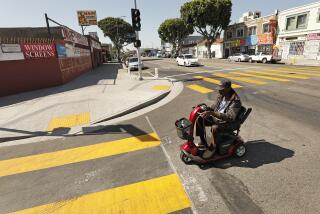More Fatalities in Darkness : Study Finds Night Traffic Deadly
More than half of all traffic deaths occur at night even though more miles are driven in daylight.
According to Friendly Exchange magazine, the fatality rate at night is triple that of the daytime death rate when factoring in miles driven. Night drivers strike and kill more than 5,000 pedestrians annually.
Lack of visibility plays an important role in these accidents. In one study, Dr. Paul Olson, a scientist with the University of Michigan Transportation Research Institute, and a colleague measured the distance drivers using low beams were able to see a pedestrian wearing dark clothes.
They compared this visibility distance with the stopping distance a car traveling at normal highway speeds would require. The results were frightening: More than 80% of older drivers would not have seen the pedestrian in time to stop.
Most people are in the dark about night vision. As a result, “people inadvertently overdrive their headlights,” says Dr. Herschel Leibowitz, a psychology professor at Pennsylvania State University.
Steering a car down the road at night requires ambient vision. Because low light does not affect ambient vision, a driver starts to feel overconfident. But recognizing a pedestrian in the road ahead depends on focal vision. It may be too late before the driver realizes the impairment of this kind of vision.
Leibowitz describes the two kinds of vision: focal and ambient. Focal vision allows us to recognize objects. Ambient vision guides us as we move. Although low light does not seriously impair ambient vision, it does affect focal vision.
To understand this, consider what happens when awakening in a nearly dark bedroom. Ambient vision allows a person to find the way to the bathroom, but focal vision is not sharp enough to read a book.
Other important factors, such as fatigue and alcohol, compound the risk. Although darkness affects everyone’s vision to some degree, older adults tend to have more trouble seeing at night than do young people. A typical 60-year-old needs 10 times more light to see an object as clearly as a 20-year-old does.
Here are some suggestions for making the most of nighttime sight:
- Clean headlights often. Dirty lenses can cut the light output by up to 90%.
- Have headlights checked and, if necessary, adjusted. Consider installing halogen headlights if the car isn’t already equipped with them.
- Keep windshield clean, inside and out. Remember that smoking not only dirties the inside of the windshield but also irritates eyes and reduces night vision.
- Guard eyes during the day. Prolonged exposure to bright sunlight without the protection of sunglasses can reduce vision at night.
- Let eyes adjust to darkness. Give eyes at least 30 seconds to adjust to the lack of light while the car engine warms.
- Use high beams whenever possible. But don’t blind an oncoming driver or the driver just ahead.
- Protect eyes from glare. Avoid looking at others’ headlights, and switch rearview mirror to the nighttime setting.
- Slow down.
“We recommend anywhere from a 20% to a 33% reduction in speed at night,” says Charles Butler, manager for driver-education programs at the American Automobile Assn. national headquarters.
Pedestrians contribute to the problem.
“Pedestrians assume that if they can see the car, the car can see them,” Leibowitz says.
Unfortunately, those who make this assumption are often dead wrong. A car with its headlights shining in the dark is very conspicuous. But pedestrians dressed in dark clothing present little contrast to the background. They may not be seen in time or even be seen at all. In one study of actual nighttime accidents, a quarter of the drivers remembered hearing an impact before seeing the pedestrian they had just run down.
Pedestrians can make themselves more visible by following these tips:
- Carry a flashlight. One study found that a pedestrian who was wearing a white T-shirt could first be seen at 224 feet, but a pedestrian carrying a flashlight can be seen 1,379 feet away.
- Wear special reflective materials. One highly visible combination includes a reflective headband, wristbands, belt and ankle bands.
- Don’t depend on light-colored clothing alone. Although better than dark clothing, a white shirt is not bright enough by itself.
- Avoid unnecessary nighttime outings. Drivers should be prepared in case a breakdown or accident makes them unexpected pedestrians.
More to Read
Sign up for Essential California
The most important California stories and recommendations in your inbox every morning.
You may occasionally receive promotional content from the Los Angeles Times.










